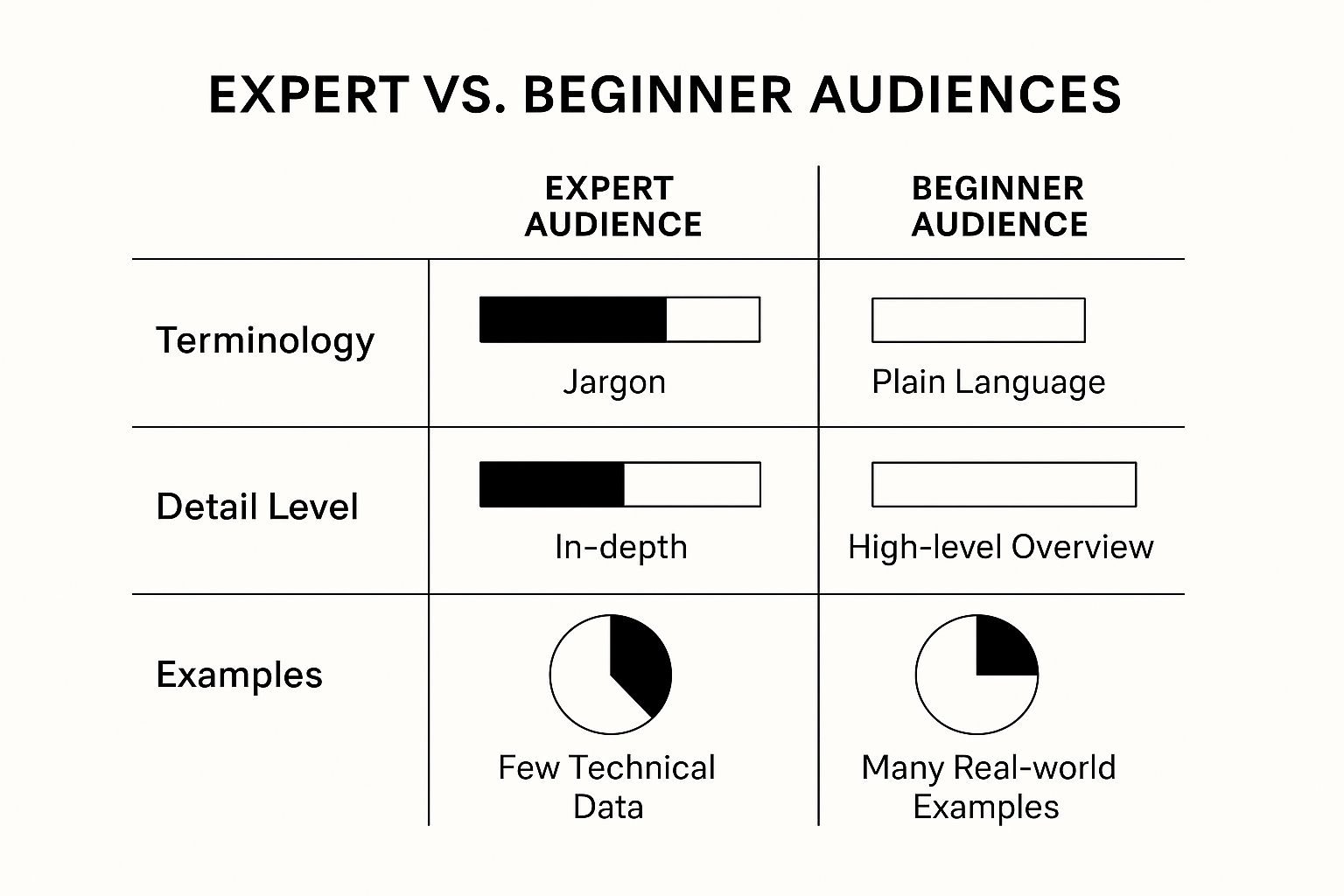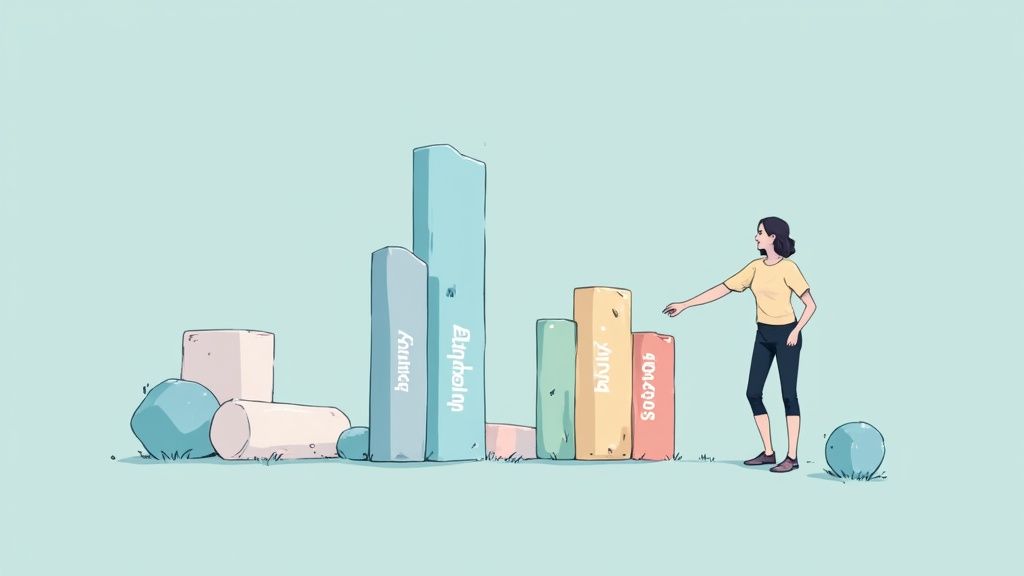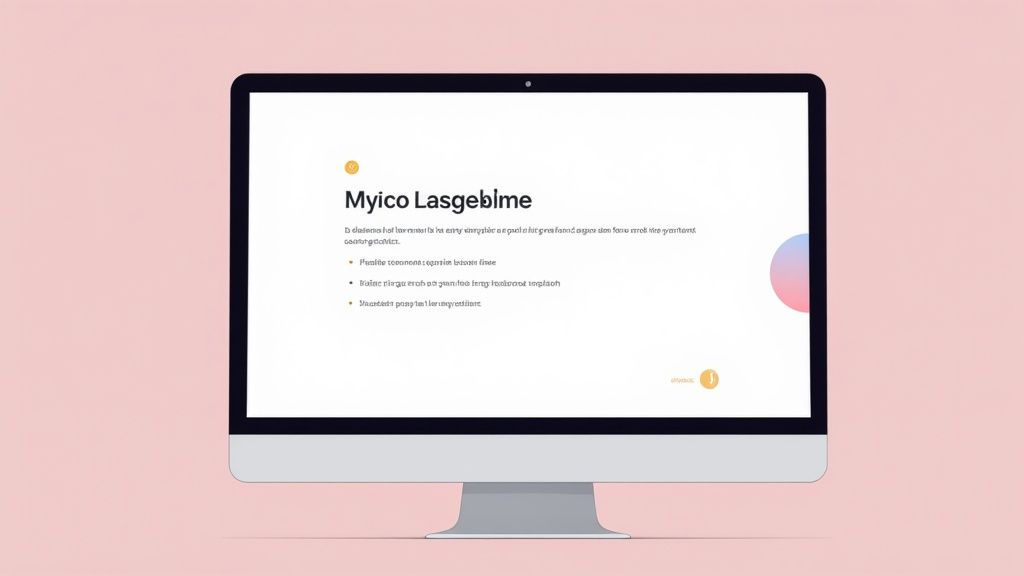How To Give A Good Presentation That Actually Connects

Published : Jul 7, 2025
Written by: Madeson Sykes
19 minutes read
Why Most Presentation Advice Falls Short
Let’s be real. How much truly helpful presentation advice have you actually found online? Googling usually gets you the same tired tips: “make eye contact,” “practice, practice, practice.” It’s like getting a lollipop when you’ve broken your arm. Thanks, but not really what I need right now.

This infographic, for example, makes a good point about knowing your audience’s expertise. Experts love jargon; beginners need real-world examples. But even this is just scratching the surface.
The real key? Truly understanding your audience. A presentation that dazzles industry veterans might bore a new client to tears, and the other way around. This means digging into their backgrounds, understanding what keeps them up at night, and speaking their language.
The Problem With Cookie-Cutter Approaches
Generic advice fails because it treats all presentations the same. But pitching to VCs is vastly different than updating your team on Monday morning. One needs hard data and polish; the other needs clear, concise updates. Even the frequency of presentations has changed. By 2025, over 50% of professionals were creating presentations weekly – way up from the monthly average in 2021. Discover more insights. This shift is largely due to remote work, where presentations are now crucial for everything from quick check-ins to major client pitches.
Authenticity Over Perfection
I learned this the hard way. I once bombed a presentation I had over-prepared for. Memorized every word, obsessed over the slides, even practiced hand gestures. I came across like a robot. The audience wanted passion, not a performance. It taught me a vital lesson: be yourself. Connect with the audience. The rest will follow.
The Shifting Landscape of Presentations
Audience expectations have changed drastically. We’re all drowning in information, so people crave connection and clear value. We’ve all sat through those soul-crushing presentations where the speaker drones on, disconnected from the room. Ouch.
Today’s audiences want a conversation—a chance to learn something, connect with the speaker, and walk away with useful takeaways. That means understanding their needs, anticipating their questions, and making space for real dialogue. This is especially important with the rise of AI in presentation tools like SlidesAI and Simplified. While AI can be amazing for design and content, your presentation still needs that human touch. AI should enhance your voice, not replace it.
To illustrate how the context of presentations has shifted, let’s take a look at this comparison:
Modern Presentation Context: Then vs Now Compare traditional presentation settings with today’s hybrid work environment requirements
| Aspect | Traditional (Pre-2020) | Modern (Today) | Impact on Presenters |
|---|---|---|---|
| Location | Primarily in-person, conference rooms | Hybrid: in-person, virtual, and asynchronous | Requires adaptable delivery and tech skills |
| Audience | Physically present, geographically limited | Distributed, diverse time zones, varied access | Demands inclusive design and messaging |
| Engagement | Q&A at the end, limited interaction | Real-time polls, chat, interactive elements | Encourages dynamic and responsive presenting |
| Content | Static slides, linear flow | Dynamic content, multimedia, personalized experiences | Necessitates engaging visuals and storytelling |
| Follow-up | Printed handouts, delayed feedback | Digital sharing, immediate feedback loops | Enables continuous improvement and data-driven insights |
This table highlights key differences: location, audience engagement, and the very nature of the content itself. Presenters now need to be tech-savvy, adaptable, and focused on creating truly interactive experiences.
Crafting Your Message Like A Master Storyteller

Ditch the stiff, textbook presentation style. Instead, think narrative. The best presentations unfold like a natural, engaging story. This doesn’t mean spinning a yarn, but presenting your information in a way that truly resonates.
Identifying Your Core Message
Before anything else, pinpoint the one key takeaway you want your audience to walk away with. What’s the central idea? Everything else should support this core message. Think of it as the foundation of a house—absolutely crucial. For instance, when pitching a new software, focus on how it solves a customer’s problem, not just its bells and whistles.
Understanding Your Audience – Doing The Detective Work
So many presentations miss the mark here. They target some vague, generic “audience” instead of the actual people in the room. Put on your detective hat. What are their pain points? What are their challenges? Are they seasoned pros, newbies, or somewhere in between? This informs how you tell your story. Presenting to a group of developers? Dive into the technical details. Presenting to investors? Focus on market potential and ROI. Need some real-world examples? Check out the Href.sh examples.
To help with this process, I often use the following framework:
Audience Analysis Framework A practical guide for understanding different audience types and tailoring your approach accordingly
| Audience Type | Primary Concerns | Preferred Content Style | Engagement Strategies |
|---|---|---|---|
| Executives | ROI, strategic alignment, big-picture impact | Concise, data-driven, focused on key takeaways | High-level overviews, clear visuals, Q&A focused on strategy |
| Technical Team | Functionality, implementation, technical details | In-depth explanations, code examples, practical demonstrations | Hands-on workshops, technical deep dives, opportunities for problem-solving |
| Marketing Team | Brand messaging, customer engagement, marketing channels | Creative examples, case studies, market analysis | Interactive sessions, brainstorming, collaborative exercises |
| General Public | Relevance to their lives, benefits, ease of use | Simple language, relatable stories, clear visuals | Engaging storytelling, interactive demos, opportunities for questions and feedback |
This framework, while not exhaustive, helps me tailor my message for different audiences. The key is to adapt it to your specific context.
Structuring Your Content For Maximum Impact
Once you’re clear on your audience and core message, structure your presentation like a compelling narrative. Grab their attention right away with a strong hook—a thought-provoking question, a surprising statistic, or a relatable anecdote. Maintain momentum by connecting your points logically, using smooth transitions like “This means that…” or “For example…” This creates a natural flow, guiding your audience through your key insights. Think of it as a journey, not an information dump.
The Power of Personal Stories
Weaving in personal anecdotes can make your presentation stick. The key is to choose stories that support your points, not just entertain. For example, when discussing overcoming a business hurdle, share a personal story about a time you faced a similar challenge and how you navigated it. This shows your audience you “get it” and offers practical solutions.
Anticipating Questions – Turning Stumbles Into Opportunities
Think ahead. What questions might your audience have? Addressing potential questions upfront shows you understand their perspectives and boosts your credibility. You can even incorporate these questions into your presentation as transitions or segues to new points. This turns potential stumbling blocks into chances to showcase your expertise and build trust. In a recent client presentation, I anticipated a tricky pricing question. By addressing it proactively, I built confidence and demonstrated transparency.
Don’t just present; connect. By understanding your audience, crafting a compelling narrative, and using personal stories strategically, you create a presentation that resonates and leaves a lasting impact. Remember, it’s not about performance, it’s about connection.
Creating Visuals That Amplify Your Voice
So many presentation guides miss the mark. They obsess over pretty slides instead of effective ones. Your slides should almost disappear, subtly supporting your message, not hogging the spotlight. Let’s dive into design principles that work even if design isn’t your forte, like picking images that actually clarify your points and using text strategically.
Less Is More: The Power of Simplicity
Think back to the presentations that stuck with you. Were they filled with flashy animations and complicated diagrams? Doubtful. Simplicity is often the key. A clean slide with a strong image and a few well-chosen words is way more powerful than a slide crammed with bullet points. From TED Talks to winning startup pitches, the best prioritize clarity. I once watched a CEO land a multi-million dollar deal with slides that were almost entirely images. The visuals narrated the story, letting him connect with the investors.
Choosing Images That Truly Enhance
Images should clarify, not decorate. A generic stock photo of a handshake adds nothing. Choose images that connect directly to your message and improve understanding. Explaining a complicated process? A simple diagram can make it instantly clear. A well-placed chart visualizes data far better than a wall of numbers. The goal? Make your message easier to understand.

This Canva screenshot shows some presentation templates. See how they prioritize clean layouts and impactful visuals? Even with pre-designed templates, clear communication is the priority, not just aesthetics.
Text: When To Use It, When To Ditch It
Too much text is a guaranteed way to lose your audience. They’ll either try to read it all, ignoring you, or just zone out. Use text sparingly, highlighting key takeaways, quotes, or crucial data points. Slides are visual aids, not teleprompters. I’ve witnessed presentations where the speaker just read the slides verbatim. The audience could have just read them themselves.
The Right Tools For The Job
The presentation software market is exploding, expected to hit $16.4 billion by 2032. This shows how vital effective presentation tools are, from classrooms to boardrooms. Discover more insights. Choose tools that simplify your workflow, not complicate it. Don’t get lost in fancy features you’ll never use. Simple, intuitive tools like Google Slides or Canva can be surprisingly powerful.
Handling Technical Disasters
Tech can be a presenter’s best friend…or worst enemy. Always have a backup. A PDF of your slides, a printed handout, or even a quick whiteboard summary can save the day if your laptop crashes. My projector once died mid-presentation. I took a breath, summarized my key points without slides, and ended up connecting with the audience better because it felt more spontaneous.
Designing For Credibility
Your visuals should boost your expertise, not undermine it. Choose professional, easy-to-read fonts, colors, and layouts. Consistency matters. A cohesive visual style makes your presentation look polished and credible. Avoid clutter, distracting animations, and anything that screams “amateur.” Your slides are an extension of your professional brand.
By focusing on clarity, simplicity, and strategic visuals, you can create presentations that amplify your message and resonate with your audience. Remember, the slides are there to support you, not steal the show.
Mastering Rhythm And Flow Under Pressure
Let’s talk presentation flow. Forget cramming every single detail into your allotted time. It’s about establishing a rhythm, a natural, engaging flow that holds your audience’s attention. Those speakers who seem effortlessly polished? They’ve nailed the art of pacing. They make even complex topics feel accessible and engaging, all within the time limit.
Structuring Your Time Strategically
Seasoned presenters know timing isn’t about fitting it all in. It’s about creating a dynamic experience. Time becomes a strategic tool, emphasizing key takeaways while streamlining supporting details. Imagine launching a new product: you’d likely focus on how it solves problems, not its technical specs. This ensures the core message lands, even if minor points get trimmed.
The Power of the Pause
Ever notice how a well-placed pause can amplify a point? It gives the audience time to process information and builds anticipation. It’s like musical phrasing—silence makes the sound pop. I remember a speaker who used a long pause after a powerful statistic. The silence was incredible, really letting the data sink in.
Rehearsing For Reality
Most advice tells you to practice until you’re comfortable. But presentations are rarely comfortable! So, rehearse with realistic constraints. Use a timer, set it even shorter than your actual time slot. This forces you to be concise and helps you prioritize. Even better? Practice with interruptions. Have a friend throw random questions at you. This simulates the unpredictability of a live audience and hones your on-the-spot thinking.
Adapting to the Unexpected
These days, presentations need to be concise and visually engaging. Studies suggest attention spans are shrinking–down to a startling eight seconds by some estimates. Check out this article for more on effective presentation lengths: Find more insights on effective presentation lengths. The point is, real life happens. Audiences get distracted, schedules shift, tech fails. Be prepared to adapt. Have a shorter version ready, focus on key takeaways, and be willing to adjust. I’ve had presentations cut short unexpectedly, and having a backup plan was a lifesaver.
Embracing Flexibility
Flexibility isn’t about being unprepared; it’s about knowing your core message inside and out and being able to deliver it in different ways. Think of a jazz musician—they have the melody, but they improvise based on the energy of the room. You should be able to adjust your pace, dive deeper into certain points, or even skip sections if needed, all while keeping your core message and credibility intact. This comes with practice and a deep understanding of your material.
Mastering rhythm and flow goes beyond just time management. It’s about crafting a compelling experience, respecting your audience’s time, and keeping them hooked on your message. Strategic structuring, realistic rehearsal, and a flexible approach are key to delivering presentations that are not only informative but truly captivating.
Commanding The Room Even When You’re Terrified

This image perfectly captures the essence of public speaking. Look at how the speaker connects with the audience; that’s what it’s all about – communication and connection. The speaker’s posture and the audience’s reactions tell a story. Confident delivery and engaging content have real power.
Here’s a little secret about presentation jitters: they’re universal. Even seasoned pros get them. The real difference isn’t if you’re nervous, but how you handle it. It’s about using that energy to connect with the people in the room.
Taming the Inner Critic: Practical Strategies
Forget those weird breathing exercises. Seriously, they can make things worse. Let’s take a page from performers and athletes. Visualize success: imagine yourself confidently delivering your key points, connecting with the audience, and nailing it. This mental rehearsal builds real confidence. Also, try reframing your nerves as excitement. That adrenaline can actually make you sharper and more engaging.
A little trick I use? I remind myself that the audience wants me to succeed. They’re there to learn something, to be inspired.
Projecting Confidence Even When Your Heart Is Racing
Body language matters. Stand tall, shoulders back, head up. This not only looks confident, it actually makes you feel more confident. Make eye contact with people in the audience. This creates a personal connection and makes the room feel less intimidating. And please, ditch the fidgeting. It’s distracting.
Vulnerability: The Unexpected Superpower
I once saw a CEO, usually very stoic, nearly cry during a presentation about a personal challenge. It was incredibly powerful and made his message resonate deeply. Authenticity connects way more than polished perfection. Embrace your imperfections. It’s okay to be nervous; it shows you care.
Handling Nightmare Scenarios With Grace
Tech fails, tough questions, even hecklers – it happens. Prepare. Have backups for tech, anticipate tricky questions, and remember, a stumble can actually build your credibility. I once saw a speaker handle a hostile question with humor and grace, winning over the entire room. These unexpected moments are chances to show your expertise and composure. You might also find Href.sh’s helpful resources useful for managing files and presentations.
From Stage Fright to Commanding Presence
I’ve worked with people terrified of speaking, who nearly bombed presentations because of nerves. With practice, preparation, and a mindset shift, they learned to own the room. They realized that vulnerability connects, and that potential disasters can become moments that actually boost their credibility. It’s a journey. Every presentation is a chance to grow, connect, and share your voice.
Creating Genuine Connection Beyond Basic Interaction
The difference between a presentation that fades into oblivion and one that truly resonates lies in genuine human connection. It’s not about flashy visuals or fancy tech, but about forging a real bond with your audience. Think of master presenters – they build rapport that feels authentic, not manufactured. They ask questions because they genuinely want to know the answer, not just to fill dead air.
It’s all about reading the room and adapting in the moment. Think of it like chatting with a friend. You pick up on their cues – their energy, their body language. Are they leaning in, engrossed in the conversation, or are they glancing at their watch? You adjust accordingly. The same principles apply to presentations. If the audience seems restless, maybe you trim a section or inject a little humor. If they’re captivated, you might explore a specific point in more detail. This adaptability shows you’re present and engaged with them.
Encouraging interaction is key, but forcing participation can create an awkward atmosphere, especially for introverts. Aim for a balanced approach that welcomes different personality types. Instead of putting individuals on the spot, provide a variety of ways to engage. A quick poll using a tool like Mentimeter can be fun and inclusive. Alternatively, offer a chat function for those who prefer to type their questions or comments.
Stories have incredible power, but they need to be purposeful. A good story illuminates your points, not distracts from them. For example, when I was presenting a new marketing strategy, I shared a story about a previous campaign that tanked spectacularly. It wasn’t just for laughs (though the audience did laugh!); it underscored the importance of the new approach. They got the joke, and they got the point.
Sometimes, presentations veer off course. An audience member might ask a left-field question, or a technical hiccup might throw you off. Embrace these unscripted moments. A well-handled tangent can lead to deeper understanding and actually boost your credibility. I once had a slide malfunction mid-presentation. Instead of panicking, I made light of the situation, and the audience appreciated the genuine, unscripted moment. It made me more relatable, more human.
Challenging questions can be invaluable. They reveal what the audience is really thinking and where they need further clarification. Don’t shy away from these opportunities. See them as a chance to demonstrate your expertise and address their concerns head-on. I remember being asked a particularly tough question about the feasibility of a new product. Instead of a canned response, I acknowledged the challenge and explained how we planned to tackle it. That honesty built trust.
Ultimately, delivering a great presentation isn’t about becoming a polished performer. It’s about connecting with your audience on a human level. It’s about building a relationship, not putting on a show. When you create that connection, your message will stick with them long after the final slide.
Extending Your Impact Beyond The Final Slide
A killer presentation doesn’t just wrap up when the Q&A is over. It’s the follow-up that really makes your message stick and helps you build real connections. The speakers who transform one-off presentations into ongoing conversations understand that the real magic often happens after everyone’s clapped and gone home.
Nurturing Relationships Through Follow-Up
Sharing resources is a great way to reinforce your expertise and show your audience you’re invested in their success. Did you mention a useful tool like Canva for design or a helpful article during your talk? Send a follow-up email with those links. Someone ask a question you couldn’t fully answer in the moment? Take the time to research it and send them a personalized response. These small gestures make a big difference.
Gathering Feedback That Actually Helps You Grow
Feedback is invaluable, but vague compliments won’t help you level up your presentation game. Ask specific questions. Instead of “What did you think?”, try “What resonated most with you?” or “What could have been clearer?” Even better, “What one takeaway will you apply this week?” That kind of targeted feedback gives you actionable insights for your next presentation.
This is a screenshot of Href.sh. Look how clean and simple that interface is! It shows how easy it is to upload and share presentations, which is super handy for getting your slides to people after you’ve finished speaking. That clear call to action and minimalist design really highlights how Href.sh prioritizes quick, no-fuss hosting.
Turning Presentations Into Relationship-Building Tools
I’ve literally seen people build entire businesses from the connections they made during and after presentations. It’s all about continuing the conversation. Connect with attendees on LinkedIn, jump into online discussions related to your topic, or even host a follow-up webinar to dive deeper into specific areas of interest. A presentation can be a powerful springboard for growing your network and unlocking new opportunities.
Sharing Your Message Effectively and Securely
The way you share your presentation is important, too. Emailing huge files is cumbersome and unprofessional. A service like Href.sh lets you create a sleek, shareable link. You can even password-protect confidential information or track who’s accessed your materials. This keeps your content organized, easy to access, and ensures it gets to those who couldn’t make it to the live event.
Want a quick and painless way to share your presentations online? Check out Href.sh. It’s hassle-free hosting that lets you focus on your message, not the tech behind it.